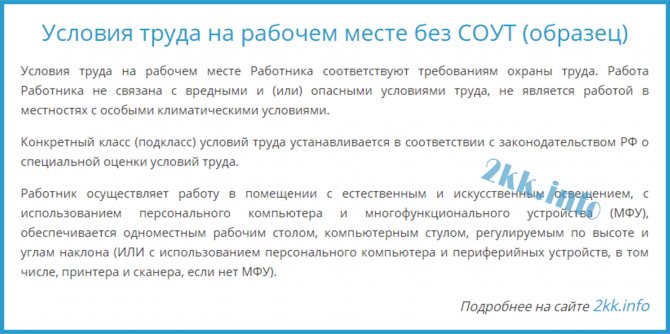Share
Since January 2014, all employers are required to indicate in the employment contract with the employee the working conditions in the workplace (paragraph 9, part 2, article 57 of the Labor Code of the Russian Federation). It doesn’t matter whether you have the results of a special assessment of working conditions or certification of workplaces, working conditions in the workplace must still be spelled out in the employment contract or in an additional agreement to it. Otherwise, you will face a fine from the labor inspectorate. And by the way, it is not small (for legal entities from 50,000 to 100,000 rubles).
Special assessment of working conditions
A special assessment of working conditions replaced workplace certification in January 2014. Federal Law No. 426 FZ dated December 28, 2013, provided for transitional provisions with a postponement of the special assessment. So, if before the date of entry into force of this law (i.e. before 01/01/2014), certification of workplaces was carried out, then a special assessment could not be carried out at these workplaces for another 5 years, as you understand, as of today, the transition period is over .
At the same time, the law provides for cases when a special assessment must be carried out unscheduled, regardless of the five-year period (Article 17 of the Federal Law No. 426-FZ of December 28, 2013).
Within 12 months from the date:
- introduction of newly organized workplaces into operation;
- changes in the technological process, replacement of production equipment (which can influence the level of exposure to harmful and (or) hazardous production factors on workers).
Within 6 months from the date:
- the employer receives an order from the state labor inspector to conduct an unscheduled special assessment of working conditions;
- changes in the composition of the materials and (or) raw materials used (which can affect the level of exposure to harmful and (or) hazardous production factors on workers);
- changes in the personal and collective protective equipment used (which can affect the level of exposure to harmful and (or) hazardous production factors on workers);
- an industrial accident that occurred at the workplace (except for an industrial accident that occurred due to the fault of third parties) or an identified occupational disease, the causes of which were the employee’s exposure to harmful and (or) dangerous production factors;
- the presence of motivated proposals from elected bodies of primary trade union organizations or another representative body of workers to conduct an unscheduled special assessment of working conditions.
Also exceptions are homeworkers (Chapter 49 of the Labor Code of the Russian Federation), remote workers (Chapter 49.1), workers who have entered into an employment relationship with an employer - an individual who is not an individual entrepreneur (Chapter 48), religious organizations (Chapter 54). In relation to these places, no special assessment is carried out at all .
What is a newly organized workplace?
Without reading anything, no letters or comments from specialists, my first thought was, since there is a word “again,” then this is the workplace that was there before, then it disappeared, and it appeared again?
If you look at Ozhegov’s dictionary with one eye, he gives a description of the word “again” as “again” and “once again”. So where are the new jobs that have never been introduced? In this regard, many questions arose from people: are the new jobs classified as newly organized ?
The Ministry of Labor of the Russian Federation in this regard issued a letter dated January 23, 2017 No. 15-1/ОOG-169, in which it wrote that the commissioning of newly organized workplaces should be understood as the date of commencement of the regular production process at these workplaces, which was previously carried out by the employer was not carried out in the new premises.
Thus, the newly organized workplace is the workplace in which the employee works, and which was not in the premises before . The Ministry of Labor of the Russian Federation was simply answering a question about moving the same workplace from one premises to another. In this case, this is also considered a newly organized workplace.
A workplace, by the way, is a place where an employee must be or where he needs to arrive in connection with his work and which is directly or indirectly under the control of the employer (Article 209 of the Labor Code of the Russian Federation).
General provisions
Before concluding an employment contract, the employer must familiarize the future employee with the company’s local regulations, job description, work schedule, and wage conditions. Next, an agreement is signed, a hiring order is issued and a corresponding entry is made in his work book (provided that the employee has not refused to continue maintaining a paper work book). After signing the contract, the parties acquire mutual rights and obligations, which they must strictly observe: the citizen undertakes to work and comply with the work schedule in force at the enterprise, and the employer undertakes to provide him with work and pay wages on time.
The agreement signed by the parties is a fundamental legal fact that determines the emergence, change and termination of the official relationship between the employer and his employee. It establishes the legal relationship between the worker and the employer and is a set of legal rules governing the official relations between the signatories of the document.
How to specify working conditions in an employment contract (sample)
In accordance with Article 209 of the Labor Code of the Russian Federation, working conditions are a set of factors in the working environment and the labor process that affect the performance and health of the employee.
According to Art. 14 of Federal Law No. 426-FZ of December 28, 2013, working conditions are divided into four classes according to the degree of harmfulness and (or) danger:
- optimal (grade 1);
- acceptable (class 2);
- harmful (3.1, 3.2, 3.3, 3.4);
- dangerous (class 4).
They are established based on the results of a special assessment of working conditions. Accordingly, we take cards for a special assessment of working conditions by position (profession) and look at line 030 “Assessment of working conditions based on identified harmful (hazardous) factors,” where the final class (subclass) of working conditions should be indicated.
We write this figure directly in the employee’s employment contract or an additional agreement to it, for example, like this:

Attention! In this article I am writing specifically about the working conditions at the employee’s workplace (a separate condition (paragraph 9, part 2, article 57 of the Labor Code of the Russian Federation), which must be in the employment contract), although in the employment contract the employer is also obliged to indicate guarantees and compensation for work with harmful and (or) dangerous working conditions (if the employee is hired in appropriate conditions, indicating the characteristics of working conditions in the workplace, paragraph 7, part 2, article 57 of the Labor Code of the Russian Federation).
What an employment contract cannot contain
Article 9 of the Labor Code of the Russian Federation states that an employment contract should not include conditions that will reduce the level of rights and guarantees of workers fixed in labor legislation. In the event that such conditions are included in the contract, they may not be applicable.
Even the voluntary consent of a worker to conditions that worsen his situation cannot relieve the employer from liability, which is established in case of violation of the law on labor relations.
For example, conditions that may worsen the employee's position include conditions for wages paid in kind in full, or a condition that provides for full compensation for damage in cases where the law provides for limited financial liability.
Thus, an employment contract presupposes the individualization of working conditions and increased guarantees for each worker.
Author of the article
How to prescribe working conditions in the workplace without SOUTH
Until the letter from the Ministry of Labor came out, which, by the way, also did not add clarity, but at least lifted the veil of uncertainty, many personnel specialists indicated in their employment contracts working conditions, who is good at what (working conditions are normal, working conditions will be determined after a special assessment (before such dates), etc.).
How can one prescribe working conditions at an employee’s new workplace when a period of one year is given for this? But Article 57 of the Labor Code of the Russian Federation requires this, without any exceptions.
The Ministry of Labor of the Russian Federation, in its letter No. 5-1/OOG-2516 dated July 14, 2016, advises that if an employee is accepted into a newly organized workplace where an assessment of working conditions has not previously been carried out, then before conducting a special assessment of working conditions in the workplace A contract with an employee hired for such a workplace may indicate the general characteristics of the workplace (description of the workplace, equipment used and features of working with it).
The Ministry of Labor of the Russian Federation did not provide any, at least approximate, formulation. And what will you write? Use your imagination again?
The Labor Inspectorate, in its online responses after the release of this letter, began to refer specifically to it, also without providing any wording. Although, you can still come across answers that until a special assessment of working conditions is carried out, nothing needs to be specified in the employment contract.
Question: A mandatory condition of an employment contract is working conditions in accordance with the results of a special assessment (optimal, acceptable, harmful, dangerous). What should be indicated in the contract if an employee is hired for a position that has just been added to the staffing table, for which a special assessment has not yet been carried out and must be carried out within 12 months?
Answer: If a special assessment of working conditions (SAL) was not carried out in relation to the newly introduced workplace, then nothing needs to be specified in the employment contract with the employee regarding working conditions at his workplace. In such a situation, it is necessary to immediately conduct a special assessment and, based on its results, conclude an additional agreement to the employment contract indicating information about the working conditions at the employee’s workplace.
Information portal of Rostrud “Online inspection of the Russian Federation”, April 2017
It is also worth mentioning the letter of Rostrud dated November 20, 2015 No. 2628-6-1, which also asked a question about working conditions when there is no special assessment. In the said letter, the department noted that Art. 57 of the Labor Code of the Russian Federation does not provide for any temporary deferrals in the fulfillment of this obligation of the employer, therefore, in order to avoid violations of labor legislation, in the absence of valid results of certification of workplaces for working conditions, a special assessment of working conditions must be carried out as soon as possible.
In fact, working conditions need to be spelled out in an employee’s employment contract. Indicate in the contract everything that the Ministry of Labor of the Russian Federation advises, namely, describe the employee’s workplace, the equipment he uses and the features of working with it (at the end of the article I provided an approximate example). Because the judicial system has not yet come to a common denominator on this issue .
The employer lost
The employer indicated in the employees’ employment contracts that “working conditions in the workplace will be determined after carrying out the special labor assessment,” which he was obliged to carry out within 12 months, because these were newly organized workplaces. There were no violations on his part; he still had time.
The Samara Regional Court, in its decision of October 2021, did not agree .
The court referred to Article 57 of the Labor Code of the Russian Federation, as well as to the above-mentioned letter of the Ministry of Labor of the Russian Federation dated July 14, 2016 No. 5-1 / OOG-2516, based on which, the employment contracts of employees must indicate the general characteristics of the workplace (description of the worker places, equipment used and features of working with it).
In addition, the court noted that failure to inform workers about the working conditions at their workplaces violates the labor rights of workers and creates a threat of harm to their life and health, since those dangerous and (or) harmful production factors that may affect workers in the process of their work.
Thus, the employer received the minimum possible administrative fine in the amount of 50,000 rubles under Part 4 of Art. 5.27 of the Code of Administrative Offenses of the Russian Federation (maximum 100,000 rubles), but there was still no indication of the working hours in the part-time worker’s employment contract, which is also mandatory for inclusion in the contract.
But a judge in the Arkhangelsk region decided that the absence of working conditions in an employee’s employment contract (without conducting a special labor assessment) is not a violation of the law.
The employer won
The employment contract of the new HR director stated that working conditions in the workplace were normal. The employer had another whole year to conduct a special assessment of working conditions.
The labor inspectorate inspected the organization in May 2021 and brought the employer under Part 1 of Art. 5.27 of the Code of Administrative Offenses of the Russian Federation (fine from 30,000 to 50,000 rubles), although it should have been under Part 4, as for improper execution of an employment contract, well, that’s not the point.
The court did not agree with the position of the State Labor Inspectorate, noting that this was a newly organized workplace, so the employer still had time to conduct a special assessment.
The court also referred to the fact that the position of “HR Director” does not belong to the category of workplaces containing potentially harmful and (or) hazardous production factors (Part 6 of Article 10 of the Federal Law of December 28, 2013 No. 426-FZ) , namely:
- workers' workplaces, professions, positions, specialties of which are included in the lists of relevant works, industries, professions, positions, specialties and institutions (organizations), taking into account which the early assignment of an old-age insurance pension is carried out;
- workplaces in connection with work in which employees, in accordance with legislative and other regulatory legal acts, are provided with guarantees and compensation for work under harmful and (or) dangerous working conditions;
- workplaces in which, based on the results of previously conducted certification of workplaces for working conditions or a special assessment of working conditions, harmful and (or) dangerous working conditions were established.
Consequently, the absence of working conditions at the workplace in the employment contract concluded with the employee is not a violation of Art. 57 of the Labor Code of the Russian Federation.
Working conditions in the workplace without SOUTH (sample)

The stated wording of working conditions is approximate! The main thing is to remember that what you write down in the employment contract can only be changed by agreement of the parties . Therefore, if your furniture and office equipment are constantly changing, then try to write general phrases, do not write about types of monitor screens (liquid crystal, based on a cathode ray tube), do not list all types of peripheral devices that an employee can use (such as an external hard drive , flash drive, uninterruptible power supply, projector, etc.). Prescribe only those things that you are 100% sure will be consistent. Also, you cannot write that working conditions are safe (optimal, acceptable), because... you don’t know about it yet (there are no special assessment results). The fact that working conditions comply with labor protection requirements. So this is the responsibility of the employer (Article 22 of the Labor Code of the Russian Federation)...
Regarding the timing of the special assessment. I wrote a general phrase, although many indicate a specific date by which a special assessment will be carried out (in the case of a newly organized workplace, this is 12 months). As I wrote above, Article 57 of the Labor Code of the Russian Federation does not make any exceptions, therefore, in order to comply with the law, a special assessment of working conditions must be carried out as soon as possible .
By the way, you can take some phrases from the sanitary rules (just don’t overdo it), at the same time you will emphasize a lot:
— SanPiN 2.2.2/2.4.1340-03 “Hygienic requirements for personal electronic computers and work organization”; — SanPiN 2.2.2.1332-03 “Hygienic requirements for organizing work on copying equipment”; — SanPiN 2.2.4.548-96 “Hygienic requirements for the microclimate of industrial premises”; — SanPiN 2.2.4.3359-16 “Sanitary and epidemiological requirements for physical factors in the workplace”; — SanPiN 2.2.0.555-96 “Hygienic requirements for working conditions for women”; - Set of rules. Administrative and domestic buildings. Updated version of SNiP 2.09.04-87.
VI. An example of an employment contract and its main points
Let's look at an example of a real employment contract with an explanation of the main points.
A cap
The header indicates the place and date of conclusion of the agreement, the full name of the parties, as well as on the basis of which documents they act.
Clause 1. Subject of the Employment Agreement
This paragraph indicates where and for what position the employee is being accepted, the place of work, the type of contract according to the nature of the employment relationship, the start date of work and the presence and duration of a probationary period.
Clause 2. Rights and obligations of the Employee
The subsection “Rights” must specify the basic rights of the Employee, including the right to rest; wages; for compensation for harm received in the performance of work duties; for social insurance; to additional rights provided for by internal regulations and the Labor Code.
The subsection “Responsibilities” indicates the main responsibilities of the Employee, including the performance of job duties; compliance with discipline, internal regulations and labor protection requirements; information about the relationship to the Employer’s property; non-disclosure of information; other duties specified in the Labor Code of the Russian Federation and regulatory documents of the company.
Clause 3. Rights and obligations of the Employer
The “Rights” subsection states the Employer’s right to incentives; to requirements to perform job duties; the right to hold the Employee accountable in accordance with the law; other rights that do not contradict the Labor Code of the Russian Federation.
The “Responsibilities” subsection specifies the Employer’s responsibilities to comply with Labor legislation, internal company regulations and agreements; on providing the Employee with work and ensuring his safety; obligation to pay wages; To provide information; carry out social insurance; compensate for possible harm caused to the Employee and other obligations.
Clause 4. Working hours and rest time
This section specifies the weekly number of working days and weekly working hours; the number of vacation days and the procedure for providing it.
Clause 5. Remuneration
The official salary and types of compensation payments are indicated here.
Clause 6. Amendment and termination of the Employment contract, dispute resolution
This section specifies the procedure in which labor disputes will be resolved and changes will be made to the employment contract, as well as the date it comes into force.
Let's summarize what has been said:
- One of the mandatory conditions that must be specified in the employment contract is the working conditions at the employee’s workplace;
- Working conditions in the workplace are established based on the results of a special assessment of working conditions, which divides conditions into four classes and subclasses (optimal (class 1), acceptable (class 2), harmful (3.1, 3.2, 3.3, 3.4), dangerous (class 4) );
- Currently, there is uncertainty regarding the indication of working conditions in the absence of a special assessment, for example, in connection with a newly organized workplace. According to the recommendations of the Ministry of Labor of the Russian Federation, in this case, it is necessary to specify the general characteristics of the workplace (description of the workplace, equipment used and features of working with it). The specific wording is at the discretion of the employer.
- The commissioning of newly organized workplaces should be understood as the date of commencement of the regular production process at these workplaces, which was not previously carried out by the employer.
- For failure to conduct a special labor assessment, a warning or an administrative fine is provided in the amount of 60,000 to 80,000 rubles (for legal entities), from 5,000 to 10,000 rubles (for individual entrepreneurs and officials), for the absence of working conditions in the employment contract - from 50,000 to 100,000 rubles (for legal entities), from 5,000 to 10,000 (for individual entrepreneurs) and from 10,000 to 20,000 (for officials).
Share
Related Posts
- Error or typo in the employment contract Errors in the employment contract. How to correct a mistake in an employment contract? Arbitrage practice.
- Salary of a part-time worker in an employment contract What salary should be indicated for a part-time worker in an employment contract? Is it possible to set a full salary? Examples from...
- Changes in labor legislation from 2021! Well, the salads have been eaten, the gifts have been given, we’ve eaten too much candy, it’s time to mentally prepare for the new work...





